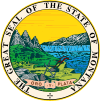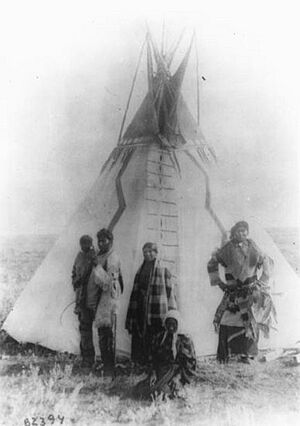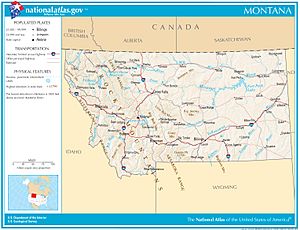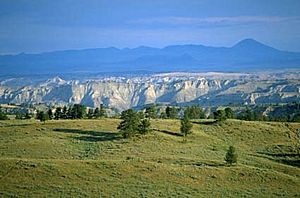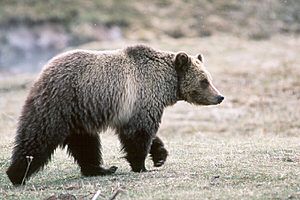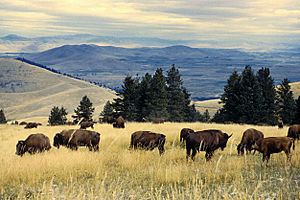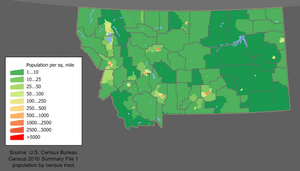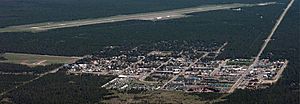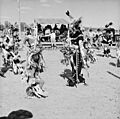Montana facts for kids
Quick facts for kids
Montana
|
|||
|---|---|---|---|
|
|||
| Nicknames:
Big Sky Country, The Treasure State
|
|||
| Motto(s): | |||
| Anthem: "Montana" | |||
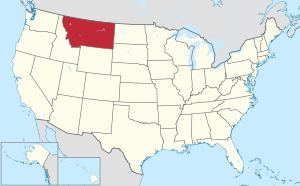
Location of Montana within the United States
|
|||
| Country | United States | ||
| Before statehood | Montana Territory | ||
| Admitted to the Union | November 8, 1889 (41st) | ||
| Capital | Helena | ||
| Largest city | Billings | ||
| Largest county or equivalent | Yellowstone | ||
| Largest metro and urban areas | Billings | ||
| Legislature | Legislature | ||
| • Upper house | Senate | ||
| • Lower house | House of Representatives | ||
| Judiciary | Montana Supreme Court | ||
| U.S. senators | Steve Daines (R) Tim Sheehy (R) |
||
| U.S. House delegation |
|
||
| Area | |||
| • Total | 147,040 sq mi (380,800 km2) | ||
| • Land | 145,552 sq mi (376,980 km2) | ||
| • Water | 1,491 sq mi (3,862 km2) 1% | ||
| Area rank | 4th | ||
| Dimensions | |||
| • Length | 255 mi (410 km) | ||
| • Width | 630 mi (1,015 km) | ||
| Elevation | 3,400 ft (1,040 m) | ||
| Highest elevation | 12,807 ft (3,903.5 m) | ||
| Lowest elevation
(Kootenai River at Idaho border)
|
1,804 ft (557 m) | ||
| Population
(2024)
|
|||
| • Total | |||
| • Rank | 43rd | ||
| • Density | 7.7/sq mi (3.0/km2) | ||
| • Density rank | 48th | ||
| • Median household income | $70,800 (2023) | ||
| • Income rank | 40th | ||
| Demonym(s) | Montanan | ||
| Language | |||
| • Official language | English | ||
| Time zone | UTC−07:00 (Mountain) | ||
| • Summer (DST) | UTC−06:00 (MDT) | ||
| USPS abbreviation |
MT
|
||
| ISO 3166 code | US-MT | ||
| Traditional abbreviation | Mont. | ||
| Latitude | 44° 21′ N to 49° N | ||
| Longitude | 104° 2′ W to 116° 3′ W | ||
| Bird | Western meadowlark |
|---|---|
| Fish | Westslope cutthroat trout |
| Flower | Bitterroot |
| Tree | Ponderosa pine |
Montana (mon-TAN-ə) is a large state in the Western United States. It's known for its amazing mountains and wide-open spaces. Montana shares borders with Idaho, North Dakota, South Dakota, and Wyoming. It also borders three Canadian provinces: Alberta, British Columbia, and Saskatchewan.
Montana is the fourth-largest state in the U.S. by land area. However, it has one of the smallest populations, making it very spread out. The state capital is Helena, and its biggest city is Billings. The western part of Montana has many mountain ranges. The eastern part features prairies and badlands, with smaller mountains mixed in.
Most of Montana became part of the U.S. in 1803 through the Louisiana Purchase. Explorers Lewis and Clark soon mapped the area. Gold was discovered in 1852, leading to a gold rush. This brought many settlers to Montana. The state officially joined the U.S. on November 8, 1889. Mining was a huge part of Montana's economy for many years.
Montana has several unofficial nicknames, like "Big Sky Country" and "The Treasure State." Its economy mainly relies on agriculture, especially ranching and grain farming. Other important resources include oil, gas, coal, and lumber. Tourism is also growing fast, with millions of visitors each year.
Contents
- What's in a Name? The Meaning of Montana
- Montana's Past: A Look at Its History
- Montana's Landscape: Geography and Nature
- How Montana is Governed
- Montana's People: Demographics and Culture
- Montana's Economy: How People Make a Living
- Learning in Montana: Education
- Montana's Culture: Arts, Events, and Sports
- Getting Around: Transportation in Montana
- Images for kids
- See also
What's in a Name? The Meaning of Montana
The name Montana comes from the Spanish word montaña. This word means "mountain" or "mountainous country." Early Spanish explorers used the name Montaña del Norte for the entire western mountain region.
In 1863, the name Montana was suggested for a new U.S. territory. Some people in Congress didn't like the name. They thought it had "no meaning." They also felt that much of the territory wasn't mountainous. They suggested Native American names instead. But in 1864, the name Montana was chosen for the new territory anyway.
Montana's Past: A Look at Its History
Many different Native American tribes lived in Montana for thousands of years. These included the Crow, Cheyenne, Blackfeet, Assiniboine, and Gros Ventres. The Kootenai and Salish tribes lived in the western parts.
The eastern part of Montana became U.S. land in 1803. After the Lewis and Clark Expedition, fur traders worked with Native Americans. They traded furs in both eastern and western Montana. The first permanent European-American settlement was St. Mary's in 1841.
Gold was first found in Montana in 1852. More gold, silver, and copper were discovered starting in 1862. This brought thousands of miners to the area. Butte became a major mining city, famous for its huge copper deposits.
Becoming a Territory: Montana's Early Days
Before it became a territory, parts of Montana belonged to other U.S. territories. Montana officially became a U.S. territory on May 26, 1864. The first capital was Bannack, then Virginia City, and finally Helena in 1875. By 1870, about 20,000 non-Native Americans lived in Montana.
Conflicts and Changes: Settlers and Native Americans
As more settlers moved to Montana, conflicts with Native Americans grew. These disputes were mainly about land. In 1855, the Hellgate treaty set boundaries for some tribal nations in western Montana. However, misunderstandings led to more problems.
The U.S. Army built posts in Montana to protect settlers. Discoveries of gold also increased tensions. Major battles took place, like the Battle of the Little Bighorn in 1876. After these conflicts, Native Americans who signed treaties often had to move to reservations.
At the same time, bison were nearly wiped out. Bison were a main food source for Native Americans. By 1884, only about 325 bison were left in the entire United States.
Ranching and Railroads: Connecting Montana
Cattle ranching has always been important to Montana. Ranchers traded cattle with people traveling on the Oregon Trail. The first Texas Longhorn cattle arrived in 1866.
Railroads also played a big role. The Northern Pacific Railroad reached Montana in the early 1880s. The Great Northern Railroad arrived later. These railroads helped bring more people and goods to Montana. They also promoted tourism, especially to Glacier National Park.
Montana Becomes a State
In February 1889, Congress approved Montana becoming a state. President Benjamin Harrison signed the bill on November 8, 1889. Montana became the 41st state in the U.S.
Homesteading: Free Land in Montana
The Homestead Act of 1862 offered free land to settlers. But 160 acres was often not enough in Montana's dry climate. Later acts, like the Enlarged Homestead Act of 1909, offered more land. This brought many new settlers to Montana.
However, many farmers faced problems. They were not ready for the dry weather and lack of trees. A severe drought from 1917 to 1921 caused many to leave. Many banks also went bankrupt. This led to fewer but larger farms in Montana.
Montana in World Wars
During World War I, about 40,000 Montanans joined the military. This was a very high number for the state's population. Montana also provided many horses for the war. The war boosted Montana's mining, lumber, and farming industries.
In World War II, over 57,000 Montanans served. This was again a large number for the state. Many Native Americans from Montana also served. Air bases were built in Montana to help send planes to allies.
Montana's Landscape: Geography and Nature
Montana is a huge state, covering about 147,040 square miles. It's slightly bigger than Japan! It's the fourth largest state in the U.S.
The state's landscape is shaped by the Continental Divide. This imaginary line splits Montana into two main parts. The western half is mostly mountains, part of the Rocky Mountains. The eastern half is mainly flat prairies and badlands.
Montana has over 100 named mountain ranges. The Bitterroot Mountains separate Montana from Idaho. East of the Divide, you'll find ranges like the Absaroka Mountains and Beartooth Mountains. Granite Peak, the state's highest point, is in the Beartooth Mountains.
Between the mountain ranges are fertile river valleys. These valleys, like the Bitterroot Valley, are great for farming and tourism. East of the mountains, the Northern Plains stretch out. This area has unique rock formations and badlands.
Rivers and Lakes: Montana's Waterways
Montana has thousands of rivers and creeks. Many are famous for "blue-ribbon" trout fishing. Montana's rivers are special because they feed into three major ocean basins: the Pacific Ocean, the Gulf of Mexico, and Hudson Bay. This happens at Triple Divide Peak in Glacier National Park.
Montana has over 3,200 named lakes and reservoirs. Flathead Lake is the largest natural freshwater lake in the western U.S. The biggest reservoir is Fort Peck Reservoir on the Missouri River. It's held back by one of the world's largest earthen dams.
Plants and Animals: Montana's Wildlife
Montana's forests cover about 25% of the state. Common trees include lodgepole pine, ponderosa pine, and Douglas fir. You can also find beautiful wildflowers like bitterroots and lupins.
Montana is home to many different animals. It has 14 types of amphibians, 90 fish, 117 mammals, and 427 bird species. There are also over 10,000 kinds of insects and other small creatures.
Montana has the largest population of grizzly bears in the lower 48 states. It also has five federally endangered species, like the black-footed ferret. The state manages hunting and fishing for many animals, including elk, pronghorn antelope, and various types of trout.
Protected Areas: Parks and Monuments
Montana is home to Glacier National Park, often called "The Crown of the Continent." Parts of Yellowstone National Park are also in Montana.
Other important protected sites include:
- Big Hole National Battlefield
- Bighorn Canyon National Recreation Area
- Little Bighorn Battlefield National Monument
- National Bison Range
These areas help protect Montana's natural beauty and history.
Montana's Weather: Climate and Seasons
Montana is a big state, so its weather changes a lot. The western mountains have milder winters and cooler summers. The eastern plains have a drier, more extreme climate. The Continental Divide acts like a wall, blocking warm air from the Pacific.
Summer days average around 84.5°F (29.2°C) in July. Nights are usually cool. The highest temperature ever recorded was 117°F (47°C). The coldest temperature ever recorded in the contiguous U.S. was in Montana: -70°F (-57°C) near Rogers Pass in 1954.
Montana's winters are becoming warmer, with fewer cold spells. This has led to more severe forest fires in recent years.
How Montana is Governed
Montana is governed by its own constitution. The first one was written in 1889. It set up a government similar to the U.S. government. In 1914, Montana gave women the right to vote. In 1916, Montana was the first state to elect a woman, Jeannette Rankin, to Congress.
Montana's government has three parts:
- Legislative Branch: This branch makes the laws. It has two parts: the Montana Senate (50 members) and the Montana House of Representatives (100 members). They meet in Helena every two years.
- Executive Branch: This branch carries out the laws. It's led by the elected governor. There are also other elected officials, like the Lieutenant Governor and Attorney General.
- Judicial Branch: This branch interprets the laws. It includes the Montana Supreme Court and other local courts.
Montana's People: Demographics and Culture
As of 2023, Montana's population was about 1.13 million people. The population has been growing, especially in larger cities like Billings and Kalispell.
Montana has a larger Native American population than most U.S. states. About 6.7% of the state's people are Native American. There are seven Indian reservations in Montana, home to 11 different tribal nations. The Little Shell Chippewa is also recognized by the state.
Montana's constitution is unique. It says the state must recognize the "distinct and unique cultural heritage of the American Indians." The Indian Education for All Act helps schools teach about Native American history and culture.
Languages Spoken in Montana
English is the official language of Montana. Most people in Montana speak English at home. Spanish is the next most common language. Many Native American languages are also spoken, such as Crow and Cheyenne.
Religion in Montana
Most people in Montana identify as Christian. The largest groups are Protestants and Catholics. There are also smaller communities of Mormons, Buddhists, and other religions. About 20% of Montanans say they are not religious.
Montana's Economy: How People Make a Living

In 2022, Montana's economy was valued at about $67 billion. The average income per person was around $60,984.
Montana is known for its many craft breweries. It ranks high in the nation for the number of breweries per person. Important industries include lumber and mining. Montana has resources like gold, coal, silver, and talc.
Tourism is also a huge part of the economy. Millions of visitors come each year to places like Glacier National Park and Yellowstone National Park. Fishing and hunting also bring in a lot of money.
Montana does not have a sales tax. Instead, it relies on income and property taxes. Some towns that get a lot of tourists can charge a "resort tax." This helps pay for services used by visitors, like road repairs.
Learning in Montana: Education
Montana has a strong education system. It includes both public and private colleges.
Colleges and Universities in Montana
The Montana University System includes several universities and colleges:
- Montana State University Bozeman (and its branch campuses)
- University of Montana Missoula (and its branch campuses)
- Community colleges like Dawson Community College and Flathead Valley Community College
There are also seven tribal colleges in Montana. These colleges serve Native American students. Four private colleges also operate in the state.
Schools: A Look at Montana's Early Education
The first schools in Montana started even before it became a territory. Early schools were often held in teachers' homes. The first formal school was at Fort Owen in 1862. It taught both Native American and settler children.
In 1864, the Montana Territorial Legislature allowed counties to collect taxes for schools. This helped create public schools. The first public school opened in Virginia City in 1866. Teachers like Sarah Raymond taught many students with limited resources.
Montana's Culture: Arts, Events, and Sports
Montana has inspired many artists, photographers, and authors. Charles Marion Russell, "the cowboy artist," created over 2,000 paintings of cowboys and Native Americans. His work is displayed at the C. M. Russell Museum Complex in Great Falls.
Authors like Wallace Earle Stegner and James Willard Schultz wrote about life in Montana. Their stories capture the spirit of the American West.
Major Cultural Events in Montana
Montana hosts many arts and cultural events each year:
- The Sweet Pea Festival in Bozeman is a large arts festival. It started in 1977 and lasts three days.
- Montana Shakespeare in the Parks performs free plays across Montana.
- The Crow Fair and Rodeo is held every August near Hardin. It's the largest Northern Native American gathering.
- North American Indian Days takes place every July in Browning.
Sports in Montana
Montana doesn't have major professional sports teams. But it has many minor league teams. Baseball is very popular, with four independent teams in the Pioneer League.
College Sports
Montana's colleges have strong sports teams. The University of Montana and Montana State University have a big rivalry. They are both part of the Big Sky Conference.
Winter Sports
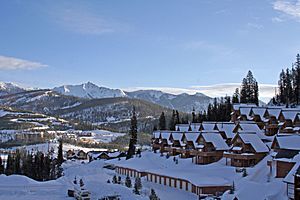
Montana is a great place for winter sports. There are 15 downhill ski areas open to the public. These include Big Sky Resort and Whitefish Mountain Resort. Many areas also offer cross-country skiing.
Snowmobiling is also popular, with over 4,000 miles of trails. West Yellowstone is a main starting point for snowmobile trips into Yellowstone National Park.
Getting Around: Transportation in Montana
Railroads have been important in Montana since the 1880s. Today, the BNSF Railway is the largest railroad. Amtrak's Empire Builder train also runs through northern Montana.
Montana has several major airports. Bozeman Yellowstone International Airport is the busiest. Others include Billings Logan International Airport and Missoula International Airport.
Interstate 90 and Interstate 94 are the main east-west highways. Interstate 15 is the only north-south interstate.
Images for kids
-
Buffalo Soldiers, Ft. Keogh, Montana, 1890. The nickname was given to the "Black Cavalry" by the Native American tribes they fought.
-
Mennonite family in Montana, c. 1937
-
The Big Drift covering the Going-to-the-Sun Road in Glacier National Park as photographed on March 23, 2006
-
St. Mary Lake in Glacier National Park
-
Quake Lake was created by a landslide during the 1959 Hebgen Lake earthquake
See also
 In Spanish: Montana para niños
In Spanish: Montana para niños



